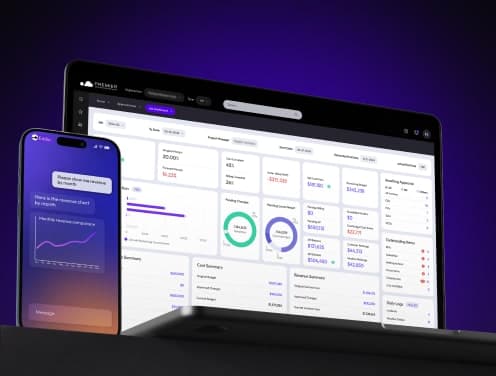
Cybersecurity Challenges and Solutions for Construction Companies
The construction industry faces a severe cybersecurity crisis. Cyberattacks hit construction companies 300% more often than other sectors. While you might have strong physical security at your jobsites, digital threats now pose just as much risk to your operations. Last year alone, cybercriminals targeted more than 70% of construction businesses. This shows an urgent need to build stronger digital defenses.
Cybercriminals target construction firms because of their valuable financial assets and strict project deadlines. These factors make projects of all sizes vulnerable to attacks. The numbers paint a concerning picture - cyber attacks on construction companies doubled between 2023 and 2024. Phishing attacks jumped by 83% while ransomware attacks grew by 41%. Your company's sensitive data makes an attractive target for criminals. This includes financial records, payment details, banking credentials, proprietary designs, and bid information.
These attacks can cripple operations completely. Take the ransomware attack on Bouygues Construction that locked up 200 gigabytes of data. Bird Construction faced a similar attack that froze 60 gigabytes of information - showing the real-life damage these incidents cause. A data breach forces you to notify affected people and the state attorney general. This creates legal headaches beyond just operational problems. The threats range from stolen money through fake invoices to broken jobsite communications. Each of these can derail your projects and hurt your profits severely.
This piece explains why big construction firms attract cybercriminals, what threats you're likely to face, how attacks affect project delivery, and what practical steps can protect your digital assets.
Why Large Construction Firms Are Prime Targets
Construction firms have become prime targets for cybercriminals. The industry now ranks as the third most common target for ransomware attacks (13.2% of total attacks in North America). Cybercriminals target construction companies for specific reasons that make your business particularly vulnerable.
High-value project data and financial records
Your company's financial transactions make it an attractive target for cybercriminals. Large payments for materials, equipment, and labor flow through your systems regularly. These high-value transactions catch criminals' attention. A recent study found that 80% of construction executives experienced at least one data breach last year. These problems are systemic throughout the industry.
Your firm's sensitive information goes beyond financial records. Project plans, blueprints, bidding data, intellectual property, access controls, and infrastructure specifications hold immense value. This risk grows even higher with government or defense contracts, where your project data attracts both profit-seeking criminals and espionage attempts.
While construction companies invest heavily in site security, they often overlook digital protection. Most construction businesses spend only 1-2% of revenue on IT and cybersecurity. That's nowhere near other industries' 3-5% investment. This gap creates an appealing scenario for attackers: valuable targets with minimal protection.
Decentralized teams and remote access points
Construction operations' distributed nature creates multiple attack entry points. Your teams work from offices, job sites, and remote locations, which fragments the security perimeter.
Site workers often use mobile devices with basic email systems, limited malware detection, and weak network protection. Public or temporary Wi-Fi networks make these risks worse. This mobile workforce expands the attack surface because employees might be less careful when they check emails or sign documents away from the office.
Teams need to communicate faster, which makes your company vulnerable to social engineering. One click on a malicious link can spread malware through your shared systems and networks. Project communications' urgent nature helps attackers exploit trust through phishing and vendor impersonation.
Low cybersecurity maturity across subcontractors
Your projects depend on suppliers, vendors, and subcontractors - each one could be the weak link in your security chain. This complex network creates multiple entry points for attackers. Each third party might follow different and often weaker security standards.
Real examples prove this risk. In 2021, hackers compromised a prominent construction accounting platform. They pushed malware to multiple contractors through a trusted software update. Partners or clients with access to Building Information Modeling (BIM) coordination or procurement systems can accidentally introduce risks if someone steals their credentials.
IBM Ponemon's research reveals that 74% of construction organizations lack proper cyberattack preparation and incident response plans. This unpreparedness runs throughout the supply chain. It creates ideal conditions for criminals: valuable assets protected by inconsistent security measures.
Project deadlines put extra pressure on construction firms to pay ransoms after an attack. Criminals know this weakness well. When systems lock during active projects, delay costs often exceed ransom demands. This gives attackers powerful leverage over your business.
Top Cybersecurity Threats in Construction
Cybercriminals now use more complex methods to target construction companies. They adapt their tactics to exploit weaknesses specific to the industry. You need to spot these threats to protect yourself from devastating attacks.
Phishing via vendor impersonation
Your company becomes vulnerable to phishing attacks that pretend to be trusted suppliers because construction projects involve many vendors. Symantec reports that one out of every 39 construction industry email users becomes a target of phishing. These tricky emails look like they come from real vendors who ask for payment updates or send harmful links and attachments.
Scammers send emails pretending to be project managers, clients, or suppliers. They try to trick your employees into sharing sensitive information or sending fraudulent payments. These attacks work especially well because construction teams work at different project sites.
Real-life impact: A construction firm lost $1.75 million when scammers pretended to be their roofing contractor. They claimed they hadn't received payment for two months. The company sent money to what they thought was a legitimate account. The scammers emptied it before anyone realized what happened.
Ransomware targeting project files
Ransomware stands out as one of the most damaging threats to construction operations. These attacks can stop your work by locking important project files and asking for money to unlock them. Construction companies depend heavily on digital systems to manage projects, store designs, and create schedules – exactly what ransomware targets.
Ransomware sneaks into your system and locks critical files until you pay money to unlock them. This leads to site shutdowns, project delays, and damage to your reputation. The effects hit hard when digital project plans and schedules become locked away. You either pay expensive ransoms or face long recovery times if your backups aren't good enough.
Ransomware attacks went up 33% from Q4 2019 to Q1 2020. The average ransom payment reached $111,605. Victims lost access to their systems for 15 days on average – a huge problem in an industry where tight schedules determine profit.
Malware from outdated software
Old software creates big security holes in construction operations. Hackers break into systems through known weaknesses in unpatched software. They steal data or disrupt operations.
Construction companies face unique risks from outdated software because:
- Project pressures and compatibility worries make many firms delay updates
- Old systems don't work well with updated subcontractor software
- Companies that don't update regularly are seven times more likely to get hit by ransomware compared to those that do
Many construction companies put off updates that might briefly interrupt work. This simple oversight gives cybercriminals an easy way in.
Social engineering through jobsite communication
Social engineering attacks target human behavior instead of technical flaws. These attacks succeed in construction settings where teams need to communicate quickly across different locations.
Attackers take advantage of how construction work flows by:
- Asking people directly to do urgent tasks
- Pretending to be senior managers with tight deadlines
- Creating pressure to make quick decisions
- Taking advantage of construction teams working at different sites
Your employees become easy targets for fake urgent messages because they need to keep projects on schedule. This problem gets worse because construction workers often can't quickly check with security teams.
DDoS attacks on cloud-based systems
Construction firms now face more risk from Distributed Denial of Service (DDoS) attacks as they switch to cloud-based project management. These attacks flood your cloud systems with traffic and block access to important project information.
DDoS attacks hit construction companies by overwhelming their cloud systems. Teams lose access to shared files, communication tools, and management platforms. This disruption stops work at multiple job sites at once and creates delays throughout your projects.
Cloud-based DDoS protection has become crucial for construction firms that rely on digital tools and project management systems. Without proper protection, these attacks can stop operations and cost you money across all your projects.
Impact of Cyberattacks on Project Delivery
A cyberattack can bring your construction projects to a complete halt. The numbers paint a grim picture, industry reports show cyberattacks cost construction firms millions yearly through downtime, stolen data, and project delays. Let's get into how these attacks affect your project delivery and profits.
Project delays from locked systems
Ransomware attacks cripple your operations by encrypting vital project management systems, design files, and scheduling platforms. A construction management company learned this the hard way when ransomware left 30 employees unable to work for 10 days while criminals held their data hostage. The whole ordeal cost them over $100,000 in lost productivity plus a $60,000 Bitcoin ransom payment.
The industry average downtime after ransomware attacks runs 15 days. Large projects can lose hundreds of thousands of dollars each day. Picture what happens when:
- You can't access digital project plans
- Scheduling software freezes during critical path activities
- Teams can't reach BIM systems and design files for field decisions
French construction giant Bouygues Construction had to shut down its entire network after ransomware infected its systems in 2020. These operational shutdowns trigger a domino effect, crews sit idle, deliveries stall, and milestone dates slip.
Loss of bidding data and competitive advantage
Cybercriminals who target your bidding strategies can wipe out your competitive edge overnight. Your confidential pricing models, supplier deals, and unique estimating methods become valuable assets that competitors could use against you.
You might not notice right away that someone has stolen your bid data. The first sign often comes when competitors start undercutting your proposals by slim margins or winning projects that used to be yours. Losing a bid means more than missing one chance, it could mean years of future work and millions in revenue slipping away.
Criminals know exactly when to strike. They target their attacks during submission deadlines, making it impossible to gather compliance materials or check crucial pricing information.
Legal exposure from data breaches
Data breaches in construction bring strict requirements to notify affected people and state attorneys general. State laws often demand these notifications within tight windows, sometimes just 30 days after discovering the breach.
The legal fallout goes well beyond notifications. Your company could face:
Civil penalties reaching $2,000 per violation with a $500,000 cap for related violations Regulatory investigations from state attorneys general and the Federal Trade Commission Class-action lawsuits from affected individuals claiming negligence
Construction companies must comply with multiple data protection regulations, which adds layers of complexity. The type of exposed information could trigger claims under state consumer protection acts or contractual liability with project owners.
Reputational damage with clients and partners
Trust breaks easily but rebuilds slowly. Research shows breach-related stock prices drop 3-5% on average, taking months to recover, if they ever do.
Your industry reputation shapes future contract awards. Major clients now demand proof of cybersecurity standards before awarding projects. A public breach raises red flags for potential clients weighing your firm against others.
Partnership impacts need serious attention too. Many construction companies work with government agencies or handle critical infrastructure where security breaches raise national security concerns. One incident could lock your firm out of these profitable contracts for years.
Weak Links in Construction Cybersecurity
The construction industry's digital revolution has created security gaps that hackers love to exploit. Security audits show 61% of construction businesses face device theft that leads to data loss. Only 1% of construction companies use proper security practices. Let's get into where your defenses might be weak.
Unsecured mobile devices on job sites
Mobile devices are your biggest security risk. Every phone or tablet that connects to project systems gives attackers a way in. The danger goes beyond stolen devices, it's about what they can access: job estimates, blueprints, inventory systems, and Wi-Fi networks.
Your field workers face higher risks because they:
- Use simple passcodes or no screen locks at all
- Connect to public Wi-Fi during breaks or at remote sites
- Skip software or operating system updates
Notwithstanding that, carelessness isn't the root cause. Workers just want to get their jobs done with the tools they have. But without proper protocols, small mistakes can cause major security breaches.
Security risks grow worse with teams spread across multiple job sites. Teams don't deal very well with unexpected requests or IT consultations in live situations. Project deadlines push employees to skip security checks and miss warning signs of suspicious activity.
Lack of MFA on project management platforms
Multi-factor authentication should be mandatory for all accounts in construction software, not just admin ones. This rule applies to field workers using tablets and mobile devices too. Many construction firms still use single-factor authentication, which creates an easy target.
BIM and IoT devices have streamlined construction work but created new weak points. These platforms store sensitive design and project data in one place, making them attractive targets.
Weak credentials let unauthorized users download, change, or leak sensitive project files. This problem often starts with shared passwords or accounts that don't need much security.
Inconsistent access control across teams
Access control systems decide who enters digital environments, when and how they do it. Construction companies struggle with these systems for several reasons.
The industry depends heavily on temporary workers, contractors, subcontractors, and third parties, which reduces security control. Old login credentials stay active after employees leave, roles change, or contractors finish their work.
Construction sites change locations often, which creates tech and security weak spots. These sites lack proper monitoring to check access events as they happen.
Security gaps show up during night shifts or crew changes. Workers grant access based on familiar faces or verbal requests and skip proper ID checks. This makes it easy for unauthorized people to get in.
Best Practices for Construction Cybersecurity
Your construction business needs protection from cyber threats. A layered security strategy will safeguard your project data and keep operations running smoothly. These four practices are the foundations of construction cybersecurity.
Mandatory MFA for all users
Multi-factor authentication serves as your best defense against credential theft. MFA reduces compromise risk by an impressive 99%, but many construction companies still use simple passwords. This security feature adds significant protection by making users verify their identity through a second method beyond passwords.
Your MFA should cover:
- Field workers using tablets for project management
- Subcontractors accessing shared documents
- Remote employees connecting to cloud systems
The quickest way to protect yourself is to use authenticator apps like Google Authenticator or Microsoft Authenticator instead of SMS-based codes. These apps create time-sensitive codes right on your devices and avoid SMS vulnerabilities like SIM swapping. MFA checks happen at every login, but you can enable "Remember this device" to make it easier - requiring MFA only every 90 days.
Quarterly cybersecurity training for staff
Human error triggers most cyber incidents. Detailed training with regular updates is one of the quickest ways to alleviate cyber risk. Your field crews need to learn about common threats like phishing and social engineering.
Training must include everyone from new hires to subcontractors. This creates a culture where security becomes everyone's job. Your quarterly refresher programs should focus on:
- Phishing awareness, spotting suspicious emails
- Password management, using centralized vault tools
- Safe internet habits, staying away from suspicious websites
- Response procedures, knowing who to call during incidents
Digital security deserves the same attention as physical safety when you add cybersecurity modules to safety protocols. You should document all training completion for compliance.
Role-based access to sensitive data
Role-based access control (RBAC) limits access based on job responsibilities. Users can only see information they need for their specific roles. RBAC assigns permissions to predefined roles like "Project Manager" or "Site Supervisor" instead of individual assignments.
RBAC follows the principle of least privilege and reduces accidental or intentional data exposure. This system offers several benefits:
- Simplified user management, roles work for multiple employees
- Better data protection, employees see only what they need
- Fewer configuration errors, standard roles close security gaps
- Easy compliance, audit trails meet regulatory requirements
Start by creating roles that match actual job functions, then set specific permissions for each role. Project managers won't see accounting data, and estimators can't access sensitive HR information.
Regular patching of legacy systems
Old software creates security holes. Hackers break into networks through known weaknesses in unpatched systems to steal data or disrupt work. Construction firms often delay updates because of project deadlines, making this risk even worse.
Companies with poor patching practices (grade D or F) are seven times more likely to face ransomware than those who update regularly. You need a schedule for:
- Automated updates for critical systems
- Regular review of available patches
- Checks that updates work everywhere
Legacy ERP systems without security updates are nowhere near as safe from cyberattacks. Modern cloud-based alternatives offer better security through regular provider-managed updates and patching.
Building a Cyber Incident Response Plan
Your strongest cybersecurity defenses can fail. A well-crafted Cyber Incident Response Plan (CIRP) becomes your roadmap to recovery when attacks slip past your safeguards. This formal document gets approval from senior leadership and guides your organization through security incidents.
Assigning roles and responsibilities
Clear roles eliminate confusion during high-pressure incidents. Your incident response team needs representatives from different departments, operations, health and safety, procurement, and legal. The core team should have three positions:
- Incident Manager (IM): This person leads the entire response without handling technical duties. They manage communications, update stakeholders, and delegate tasks while keeping track of timelines.
- Technical Manager (TM): Your subject matter expert coordinates technical response. They can bring in additional internal or external experts with proper authorization.
- Communications Manager (CM): Takes care of media interactions, social media updates, and external stakeholder communications.
Document these roles in a RACI chart (Responsible, Accountable, Consulted, Informed) and assign backups because people take vacations or might be unavailable.
Steps for containment and recovery
Your plan should outline specific procedures to stop attacks before they overwhelm resources or cause more damage. Containment strategies depend on:
- The damage potential
- The need to maintain critical services
- Whether the solution is temporary or permanent
Effective containment starts by proving it right the attacking host's IP address, which lets you block their communication channels. The eradication phase removes all elements of the incident from your environment after containment. This includes finding affected hosts, removing malware, and resetting compromised passwords.
Communication protocols with stakeholders
Your response to an incident can turn into a full-blown crisis without proper communication. Your plan should spell out who needs updates about security breaches, which channels to use, and what details to share.
The protocol must cover communications with operations teams, senior management, affected parties inside and outside your organization, law enforcement, and media. Pre-approved templates save valuable time and help you avoid crafting important messages under pressure.
Internal updates need a communication lead who knows the right people to contact through group chats, phone trees, or face-to-face meetings if everyone works on site.
Testing and updating the plan annually
Untested plans often fail when you need them most. We tested our incident response plan through tabletop exercises, simulations where team members discuss their response to various scenarios.
Run these exercises at least twice yearly, with more frequent testing if your operations or risk profile changes by a lot. A formal retrospective meeting (sometimes called a "postmortem") should follow each test or actual incident to identify successes and failures.
The retrospective stays blameless and focuses on systemic improvements rather than pointing fingers at individuals. Your staff should know about plan updates, this transparency builds trust and shows your steadfast dedication to security.
Cyber Insurance for Construction Firms
Cyber threats keep growing, and insurance has become a vital safety net for construction companies. Construction businesses face average ransomware losses of $264,000. Financial stability needs protection just as much as digital defenses.
Coverage for ransomware and data loss
Cyber insurance protects your construction firm from devastating financial losses after an attack. One excavation company learned this lesson the hard way. Ransomware locked their network and cost them $100,000 in ransom plus nearly $1 million in recovery work. A complete policy usually covers:
- First-party expenses like forensic investigations and victim notifications
- Lost income when systems go down
- Recovery costs for damaged technology or equipment
- Ransomware payments if absolutely needed
Standard jobsite insurance won't protect your digital assets. Technology disruptions, even brief ones, can hurt your revenue and damage client relationships. This makes cyber coverage essential.
Policies with crisis management support
Quick response after a breach can speed up recovery. Good cyber policies give you 24/7 access to breach response teams. These teams handle everything from IT forensics to legal counsel and public relations.
"When the dust settles after a cyberattack, it's not just your IT systems that need rebuilding. It's your finances, your schedule and your reputation," says one industry expert.
Evaluating downstream liability clauses
Your supply chain connections create special insurance needs. Look for policies that cover downstream contractual penalties from cyber-related production delays. Make sure you're covered for events that affect your vendors and suppliers.
Construction projects depend heavily on the supply chain. Any disruption can affect project delivery by a lot. Good cyber insurance limits financial damage when breaches happen anywhere in your network of partners and suppliers.
Note that cyber insurance isn't optional anymore for construction firms. But it works alongside strong cybersecurity practices, not instead of them. The best protection combines complete coverage with ongoing security improvements across your organization and project partners.
Evaluating Third-Party Risk in the Supply Chain
Subcontractors are essential partners but they can create security vulnerabilities in your system. Verizon reports that third parties now cause 30% of all breaches, which is twice the number from previous years. These numbers show why you need to examine your supply chain security right now.
Cyber hygiene audits for subcontractors
Your team must assess each vendor's security posture through detailed questionnaires before giving them system access. The assessment should check:
- Documentation of software/hardware design processes
- Vulnerability management capabilities
- Configuration management procedures
- Malware protection measures
Many companies now perform on-site security evaluations after vendors become part of their supply chain.
Vendor compliance with data protection standards
Construction projects with many subcontractors must follow GDPR compliance rules. The SHIELD Act makes vendors directly responsible when they handle private information and requires reasonable safeguards. A dedicated compliance officer can help streamline your data protection efforts.
Contractual obligations for breach response
Every vendor contract needs clear cybersecurity clauses. The contract should specify what vendors must pay for data breaches and when they need to report incidents. Your agreements should clearly state expectations about encryption, access controls, and breach reporting duties. Regular security reviews help maintain accountability even after contract signing.
Conclusion
Your digital security can't be an afterthought anymore as cyber threats against construction companies multiply. Construction firms face 300% more cyberattacks than other industries. This reality highlights the need for a complete protection strategy that balances physical jobsite security with reliable digital defenses.
Phishing attacks and ransomware threaten your operations at their core. These attacks target your most valuable assets – project files, financial data, and bidding information. A single successful breach can lock your systems, delay projects, drain finances, and damage your reputation with clients and partners.
Security gaps still plague most construction businesses. Cybercriminals easily exploit unsecured mobile devices, weak authentication, and inconsistent access controls. On top of that, your interconnected network of subcontractors spreads these vulnerabilities throughout your supply chain.
A multi-layered approach works best for defense. Start by implementing mandatory multi-factor authentication across your organization to reduce compromise risk. Make sure all staff, including field crews, undergo quarterly cybersecurity training. Set up role-based access to sensitive data that limits exposure through the principle of least privilege. Keep all systems regularly patched to close known vulnerabilities before attackers exploit them.
Being ready for security incidents matters just as much as preventing them. Your company should have a documented incident response plan with clear roles, containment procedures, and communication protocols. Regular testing and updates help this plan work when a real breach happens.
Cyber insurance provides another crucial layer of protection. The right policy covers ransomware payments, data loss, and crisis management expenses. You get protection against direct attacks and liability from security failures anywhere in your supply chain.
Distributed teams, tight deadlines, and complex partner networks create unique cybersecurity challenges in construction. All the same, your organization can substantially reduce risk through systematic assessment, consistent security practices, and technology partners who understand these specific vulnerabilities.
Premier construction ERP software offers secure, cloud-based construction project management solutions built for construction companies like yours. These tools address critical security gaps while keeping your projects running smoothly.
Cybersecurity has evolved beyond IT to become crucial for business success. Your dedication to stronger digital defenses protects your current operations and future competitive position in an increasingly connected construction world.





















